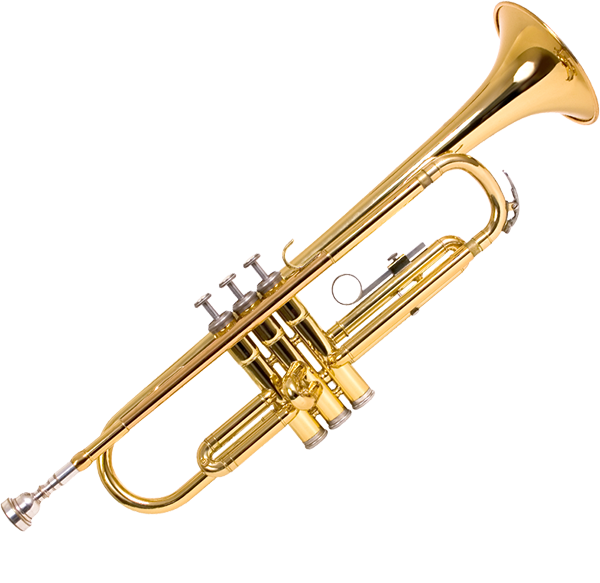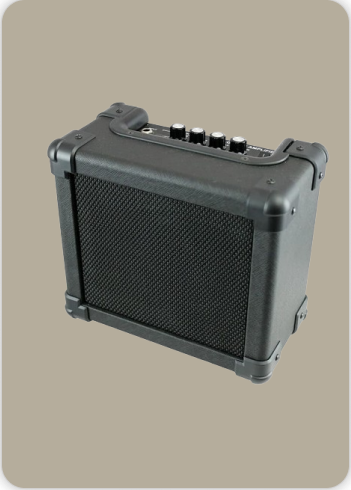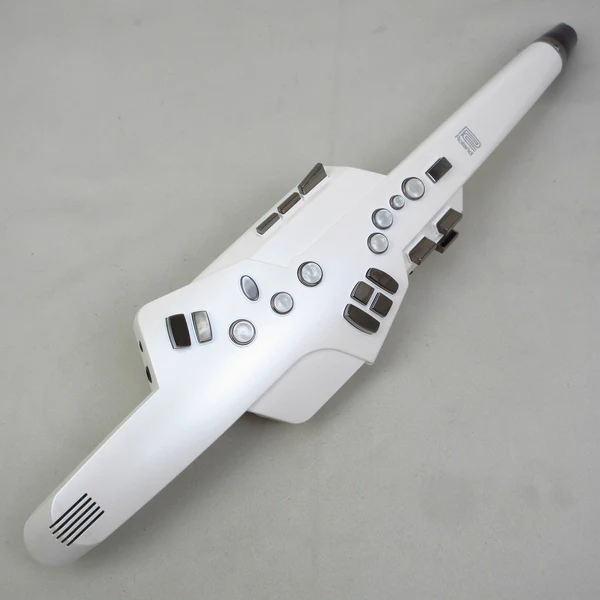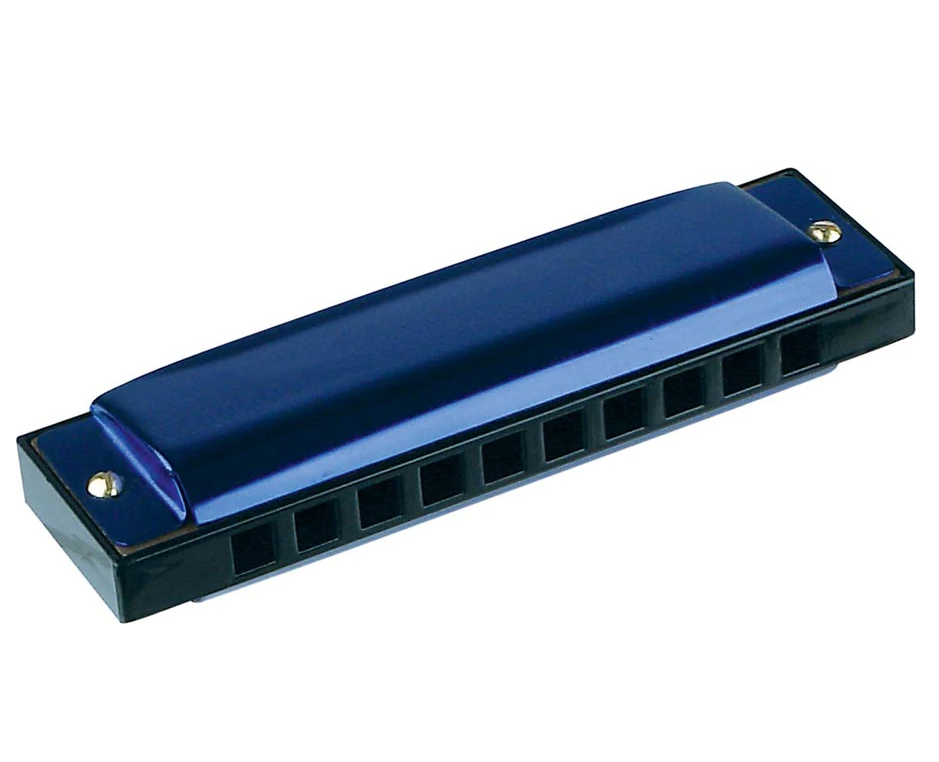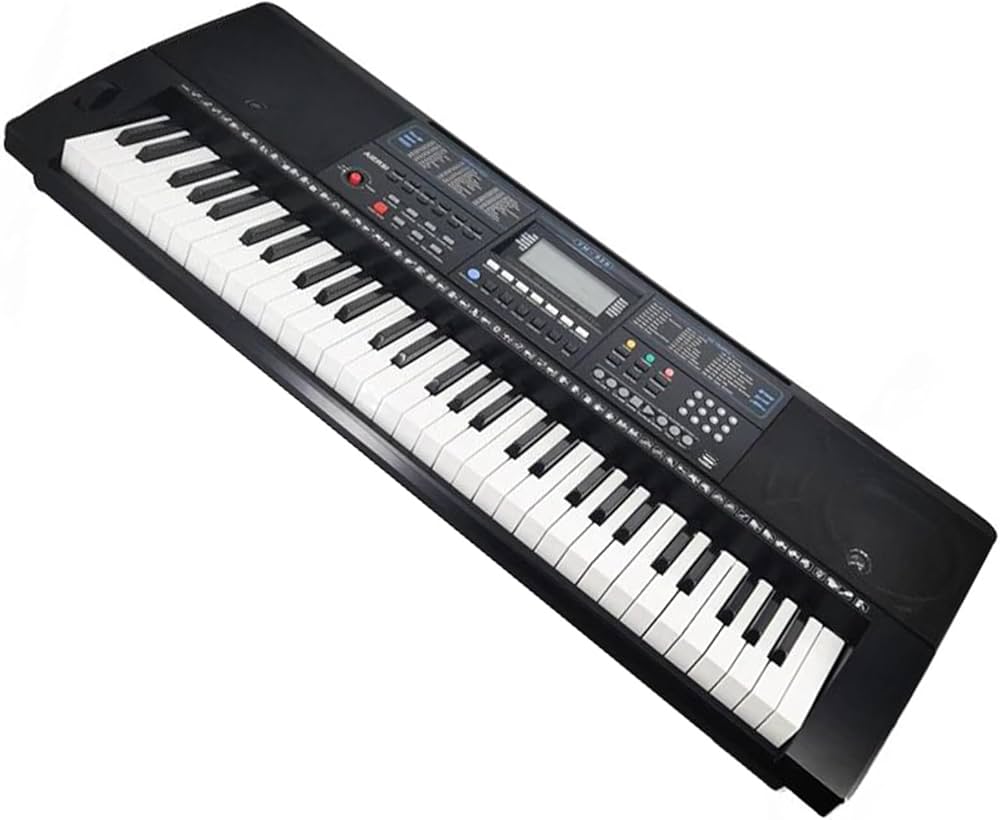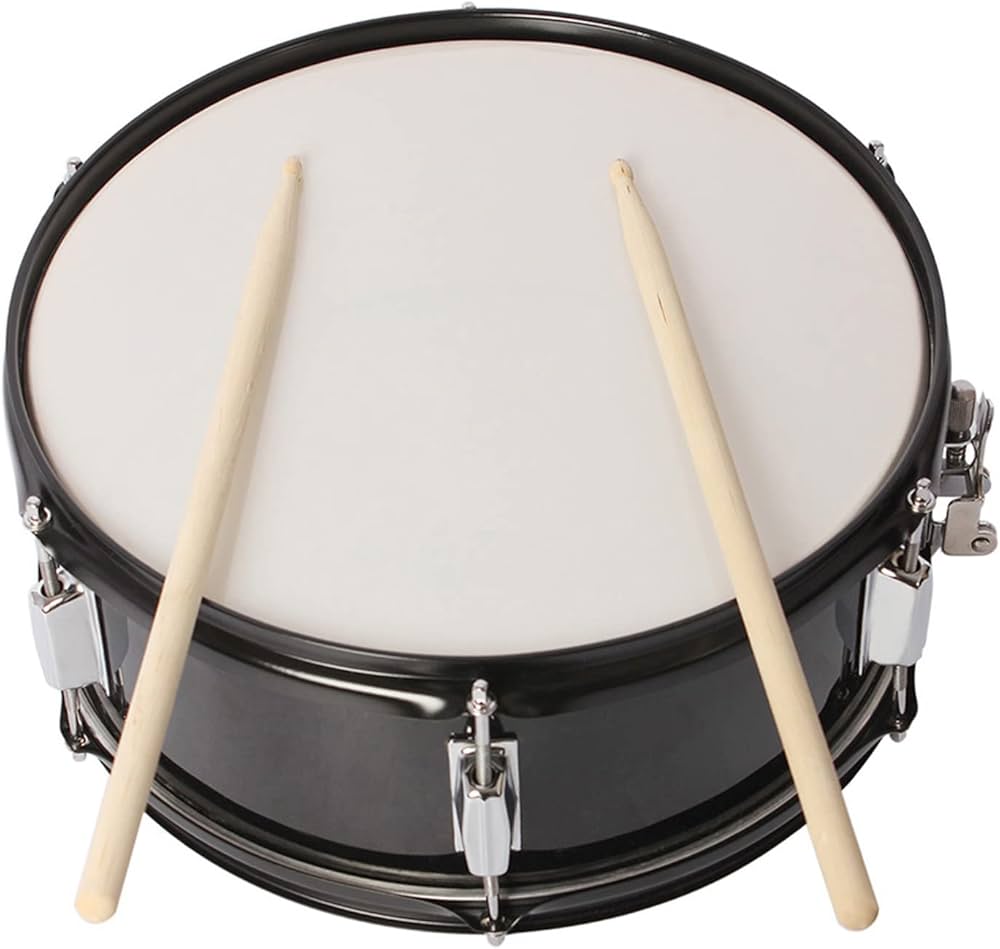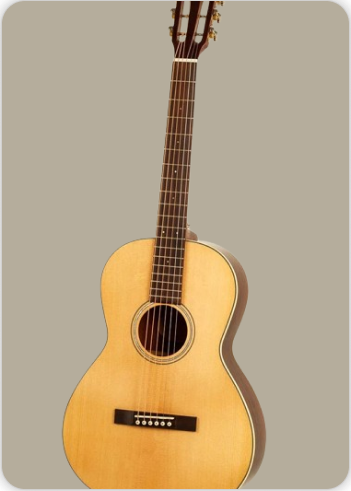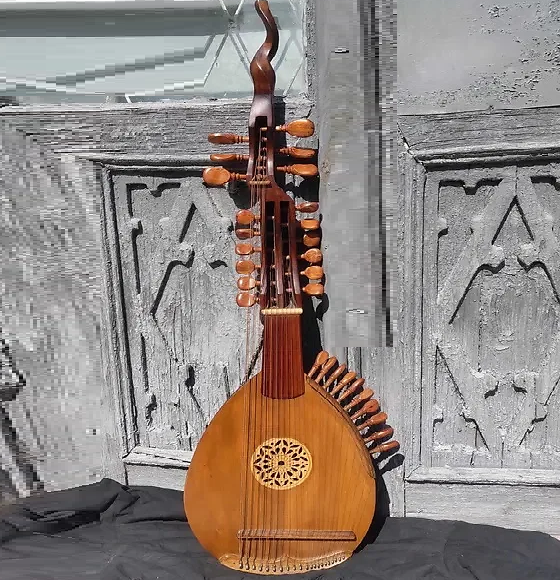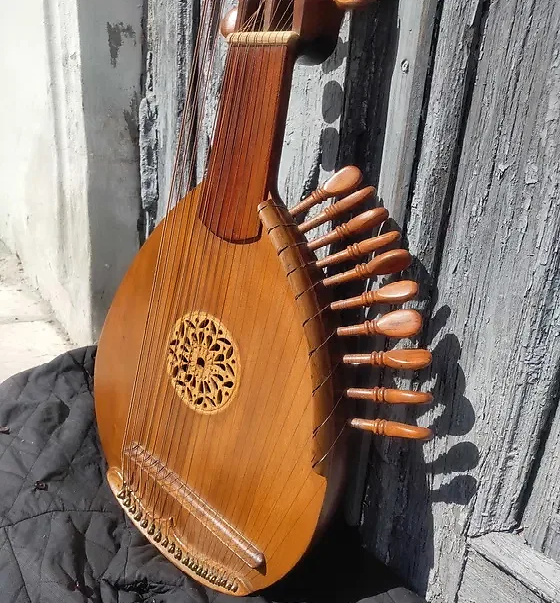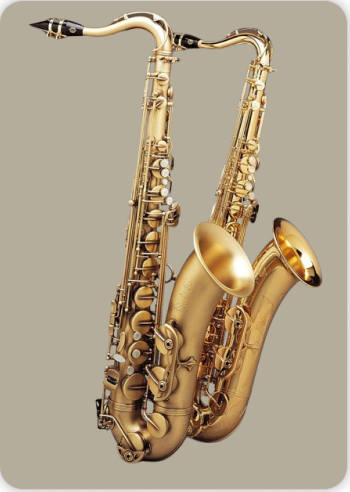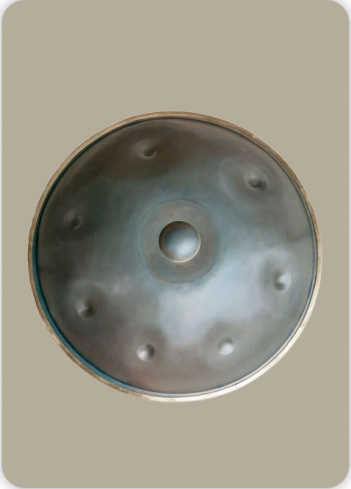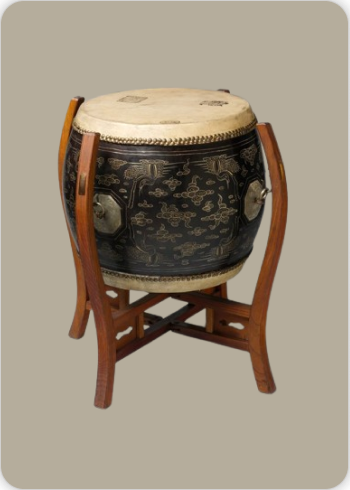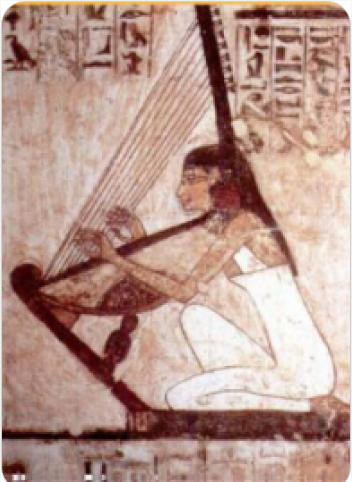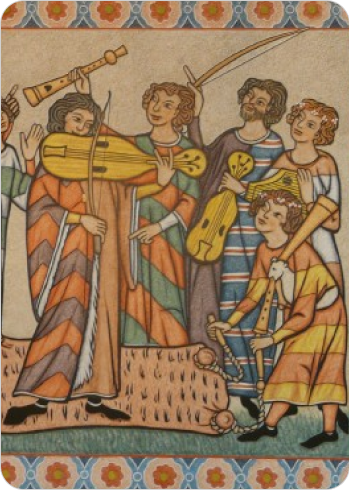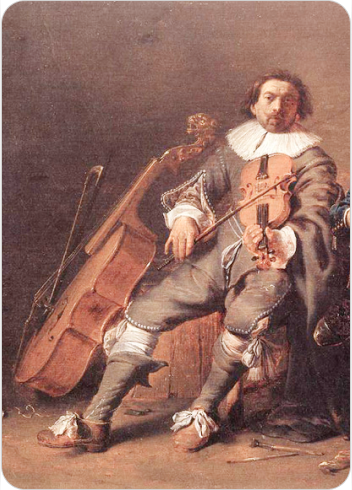Torban
Plucked Instruments
Europe
Between 1001 and 1900 AD
Video
The torban is a unique and historically significant Ukrainian musical instrument, distinguished by its hybrid construction and rich, resonant sound. It is a plucked string instrument that combines features of the Baroque lute and the psaltery, resulting in a complex and visually striking instrument. The torban is characterized by its large, rounded body, long neck, and the presence of two pegboxes. One pegbox, located at the end of the neck, holds the bass strings, while a secondary pegbox extends from the neck to accommodate additional bass strings. What sets the torban apart from similar instruments is the inclusion of short, unfretted treble strings, known as “prystrunky,” which are strung along the treble side of the soundboard. These strings add a shimmering, harp-like quality to its sound and expand its musical capabilities.
Type of Instrument: The torban belongs to the family of plucked string instruments, specifically classified as a type of lute. It is closely related to the theorbo and the bandura, but it stands out due to its unique combination of features. The torban is sometimes referred to as a “Ukrainian theorbo” or a bass variation of the bandura, but it is distinct in both construction and sound. It is typically considered a chordophone, as its sound is produced by the vibration of strings stretched between fixed points. The presence of both fretted and unfretted strings, as well as its dual pegbox system, places the torban in a unique position among European lutes and related instruments.
History of the Torban
The torban emerged in the second quarter of the 18th century, primarily in Ukraine, though it was also occasionally found in neighboring Poland and Russia. Its development was likely influenced by the central European theorbo and the angelique, instruments that Ukrainian Cossack mercenaries may have encountered during the Thirty Years’ War. According to some sources, the invention of the torban is attributed to Tuliglowski, a Paulite monk from Jasna Gora, who is said to have designed the instrument between 1736 and 1740. The torban gained popularity among the Ukrainian gentry and nobility, where it was known as the “bandura of the pans” (landowners). It became an integral part of urban culture in Ukraine, especially in regions under Russian, Polish, and later Austro-Hungarian control. Despite its aristocratic associations, many of its practitioners came from humble backgrounds, including Ukrainians and Jews, with only a few belonging to the aristocracy.
During the late 18th and early 19th centuries, the torban was brought to Russia, where it found a place in taverns and public houses. However, its popularity began to wane in the early 20th century, partly due to the high cost of manufacture and maintenance, as well as changing social and political attitudes. After the Russian Revolution, the torban was deemed insufficiently proletarian and was discouraged, leading to its gradual disappearance from mainstream musical life. Today, approximately 40 torbans survive in museum collections around the world, with the largest group of 14 instruments located in St. Petersburg. The instrument’s legacy lives on through the efforts of musicians and scholars dedicated to its revival and preservation.
Construction and Physical Structure
The torban’s construction reflects its hybrid nature, combining elements of the lute, theorbo, and psaltery. Its body is typically large and rounded, with a deep soundbox that enhances its resonance and projection. The top of the body, or soundboard, is usually made of spruce, while the back and sides are constructed from hardwoods such as maple or walnut. The instrument’s neck is long and wide, accommodating both fretted and unfretted strings. One of the most distinctive features of the torban is its dual pegbox system. The main pegbox, located at the end of the neck, holds the bass strings, which are fretted and played with the left hand. A secondary pegbox extends from the neck, holding additional bass strings known as “tors.” These strings are typically unfretted and provide a rich, resonant bass foundation.
The torban also features a set of short, unfretted treble strings, or “prystrunky,” which are strung over the right side of the soundboard. These strings are plucked with the right hand and contribute to the instrument’s distinctive, harp-like sound. The number of strings on a torban can vary, but most instruments have between 30 and 40 strings in total. The strings of the torban are traditionally made from gut, which produces a warm, mellow tone. The instrument is played by plucking the strings with the fingers of both hands, allowing for a wide range of expressive possibilities. The torban’s tuning and string arrangement can vary depending on the maker and the preferences of the player.
Types of Torban
While the torban is generally considered a single type of instrument, there are variations in its design and construction that reflect regional preferences and the evolution of musical styles. Some torbans are more closely related to the theorbo, with a greater emphasis on bass strings and a more elongated neck. Others resemble the bandura, with a deeper body and a larger number of treble strings. The main distinctions among torbans are based on the number and arrangement of strings, the shape and size of the body, and the materials used in construction. Some instruments are highly ornate, with intricate inlays and decorative elements, while others are more utilitarian in design. The presence and configuration of the “prystrunky” treble strings can also vary, with some torbans featuring a larger number of these strings for greater melodic flexibility. In addition to these physical variations, the torban has been adapted for different musical contexts. In its heyday, it was used for both solo and ensemble performances, and its repertoire included both folk and classical music. Today, modern reconstructions of the torban are sometimes built to suit contemporary performance practices, with adjustments to tuning, stringing, and construction techniques.
Characteristics of the Torban
The torban possesses a number of unique characteristics that set it apart from other stringed instruments. Its sound is warm, resonant, and complex, with a distinctive blend of bass and treble tones. The use of gut strings contributes to its soft, mellow timbre, while the combination of fretted and unfretted strings allows for a wide range of expressive possibilities. One of the most notable features of the torban is its ability to produce both melodic and harmonic textures. The fretted bass strings provide a solid harmonic foundation, while the unfretted treble strings add brightness and clarity to the sound. This makes the torban well-suited to both accompaniment and solo performance. The torban’s construction also allows for a high degree of technical versatility. Players can execute intricate fingerpicking patterns, rapid melodic runs, and complex chordal passages. The instrument’s large number of strings and extended range make it capable of covering a wide spectrum of musical styles, from folk songs to classical compositions.
Despite its technical demands, the torban is known for its expressive potential. Skilled players can evoke a wide range of emotions, from gentle lyricism to dramatic intensity. The instrument’s association with the Ukrainian gentry and its role in urban musical culture have contributed to its reputation as a symbol of refinement and artistic sophistication.
Playing Techniques and Sound Modifications
The torban is played horizontally, resting on the lap, and is plucked with the fingers of both hands. This approach allows for a nuanced control over dynamics and articulation. The right hand typically plucks the strings, while the left hand presses on the frets to change pitch, similar to the technique used on the lute. One of the torban’s defining features is its combination of fretted bass strings and unfretted treble strings, known as prystrunky. The bass strings, which are longer and run along the neck, provide a deep, resonant foundation, while the prystrunky are shorter, positioned along the treble side of the soundboard, and are played open, offering a bright, bell-like timbre.
Players can modify the sound by varying plucking strength, using different parts of the finger, or employing nail versus flesh for attack. The gut strings contribute to the instrument’s warm, mellow sound, but also require a delicate touch and precise finger placement. Advanced techniques include rapid alternation between bass and treble strings, complex arpeggios, and ornamentation such as trills and mordents. The torban’s layout encourages polyphonic playing, with the left hand managing chords and melodic lines on the fretted strings, while the right hand intersperses melodic or harmonic embellishments on the prystrunky. Sound modifications are also achieved by muting strings with the palm or fingers, creating staccato effects, or by brushing across multiple prystrunky for shimmering textures.
Famous Compositions
The surviving repertoire for the torban is limited, reflecting its decline in popularity and the oral tradition in which much of its music was transmitted. The best-documented compositions are a group of songs from the repertoire of Franz Widort, collected by the Ukrainian composer and ethnographer Mykola Lysenko and published in the journal “Kievskaya Starina” in 1892. Another significant collection is by Tomasz Padura, published in Warsaw in 1844. These works often blend folk melodies with elements of art music, showcasing the torban’s capacity for both accompaniment and solo performance. Many compositions for torban were never written down, instead passed from teacher to student or performed in salons and gatherings. The instrument was frequently used to accompany singing, with the torbanist providing both harmonic support and melodic interludes. Some pieces were adapted from the repertoire of the bandura or kobza, further blurring distinctions between Ukrainian plucked string traditions. In modern times, musicians like Maria Viksnina have begun to revive and reinterpret historical pieces, sometimes arranging music originally intended for lute or theorbo to suit the torban’s unique structure.
Most Influential Players
The torban’s history is marked by several influential players who contributed to its development and popularity. The Widort family stands out, producing three generations of torbanists: Gregor Widort, his son Cajetan, and grandson Franz. Their performances and teaching helped establish the torban’s reputation in Ukraine and beyond. Another notable figure is Andrey Sychra, a virtuoso originally from Lithuania, who was renowned for his skill and expressive playing. In the contemporary era, Maria Viksnina has emerged as a leading advocate for the torban. Born in Zaporozhye, Ukraine, she has dedicated her career to reviving the instrument, performing both historical and newly arranged works, and introducing the torban to classical music audiences in Europe. Her efforts have inspired renewed interest in the torban among musicians and scholars.
Historical Performances or Concerts
During its heyday in the 18th and 19th centuries, the torban was a fixture in the salons and courts of Ukrainian gentry and Cossack officers. It was often played at private gatherings, aristocratic events, and in urban settings where the elite would showcase their cultural refinement. The instrument also found a place in taverns and public houses, especially after its popularity waned among the nobility. Historical performances were characterized by a blend of vocal and instrumental music, with the torban accompanying singers or serving as a solo instrument. The torban’s association with the upper classes eventually contributed to its decline after the Russian Revolution, when it was deemed insufficiently proletarian and fell out of favor. Nevertheless, accounts of performances by the Widort family and other virtuosi have survived, attesting to the instrument’s expressive capabilities and its central role in Ukrainian musical life. In recent years, musicians like Maria Viksnina have staged concerts dedicated to the torban, often featuring reconstructed or newly composed works. These performances aim to recreate the atmosphere of historical salons while introducing modern audiences to the torban’s distinctive sound.
Maintenance and Care
Maintaining a torban requires specialized knowledge due to its complex construction and use of gut strings. The instrument’s body, typically made from high-quality woods, must be protected from humidity and temperature fluctuations to prevent warping or cracking. Regular cleaning with a soft, dry cloth is essential to remove dust and oils that can degrade the finish and strings. The gut strings, while contributing to the torban’s characteristic sound, are sensitive to environmental changes and can break easily. Players must regularly inspect and replace strings, ensuring they are properly tensioned and not frayed. Tuning the torban is a meticulous process, as the instrument may have 30 or more strings, each requiring precise adjustment. The tuning pegs and pegboxes should be kept free of debris and occasionally lubricated with a small amount of peg compound to ensure smooth operation. Frets, often made of gut or metal, should be checked for wear and replaced as needed. The bridge and soundboard must be monitored for signs of stress or damage, as these components are crucial for sound production. When not in use, the torban should be stored in a hard case, away from direct sunlight and sources of heat or moisture.
Interesting Facts and Cultural Significance
The torban occupies a unique place in Ukrainian musical history, symbolizing both cultural sophistication and the blending of Eastern and Western musical traditions. Its design combines elements of the Baroque lute and the psaltery, reflecting influences from Central Europe and the broader lute family. The addition of prystrunky sets the torban apart from related instruments, enabling a broader range of timbres and playing techniques. Historically, the torban was associated with the Ukrainian gentry and Cossack officers, earning it the nickname “the bandura of the pans” (landowners). This aristocratic connection contributed to its prestige but also to its eventual marginalization after social and political upheavals in the 20th century. The torban’s decline was hastened by its high cost of manufacture and the technical difficulty of playing and maintaining the instrument. Only a handful of luthiers were skilled enough to build torbans, and today, fewer than 50 authentic instruments survive, with the largest collection housed in St. Petersburg.
The torban’s repertoire was shaped by oral tradition, with many pieces never written down. This has made the reconstruction of its music challenging for modern performers. The instrument’s expressive range and ability to accompany both folk and art music have inspired contemporary musicians to explore its possibilities anew. In recent years, the torban has experienced a modest revival, thanks in part to the efforts of dedicated performers and scholars. Its distinctive sound and historical associations make it a symbol of Ukrainian cultural heritage. The torban’s story also highlights the fluid boundaries between folk and elite musical traditions, as well as the impact of political and social change on the fate of musical instruments. The instrument’s visual appearance is striking, with its long neck, dual pegboxes, and array of strings creating an imposing yet elegant profile. The torban’s construction and decoration often reflected the wealth and taste of its owners, with intricate inlays and fine craftsmanship. One particularly interesting fact is the confusion between the torban and the bandura, another Ukrainian plucked string instrument. In the early 20th century, some banduras were built to resemble the torban, leading to misidentification and further complicating the instrument’s history.
The torban’s resurgence in the 21st century, led by musicians like Maria Viksnina, underscores its enduring appeal and the ongoing fascination with Ukraine’s musical past. As more performers and audiences discover the torban, it continues to inspire new music and fresh interpretations of historical repertoire, ensuring its place in the evolving tapestry of world music.
FAQ
What type of instrument is the Torban and how is it constructed?
The Torban is a plucked string instrument combining features of the Baroque lute and psaltery. It has a large rounded body, an extended neck, and multiple string banks. It usually includes both fretted and unfretted strings. Its construction allows rich harmonic accompaniment and solo performance.
What is the historical background of the Torban?
The Torban emerged in Ukraine in the 18th century, influenced by Western European and Eastern musical traditions. It became popular among the nobility and was often played by blind minstrels. Over time, it faded due to political and cultural shifts. Today, it's being revived in folk and academic music scenes.
What are the musical applications and uses of the Torban?
The Torban is used for solo performances, accompaniment of vocal music, and folk storytelling. Its range and dual-string setup allow complex textures and drone effects. Modern musicians also explore its potential in classical and contemporary folk fusions. It's valued for its unique, resonant tone.
 Links
Links
References
Other Instrument
Categories

